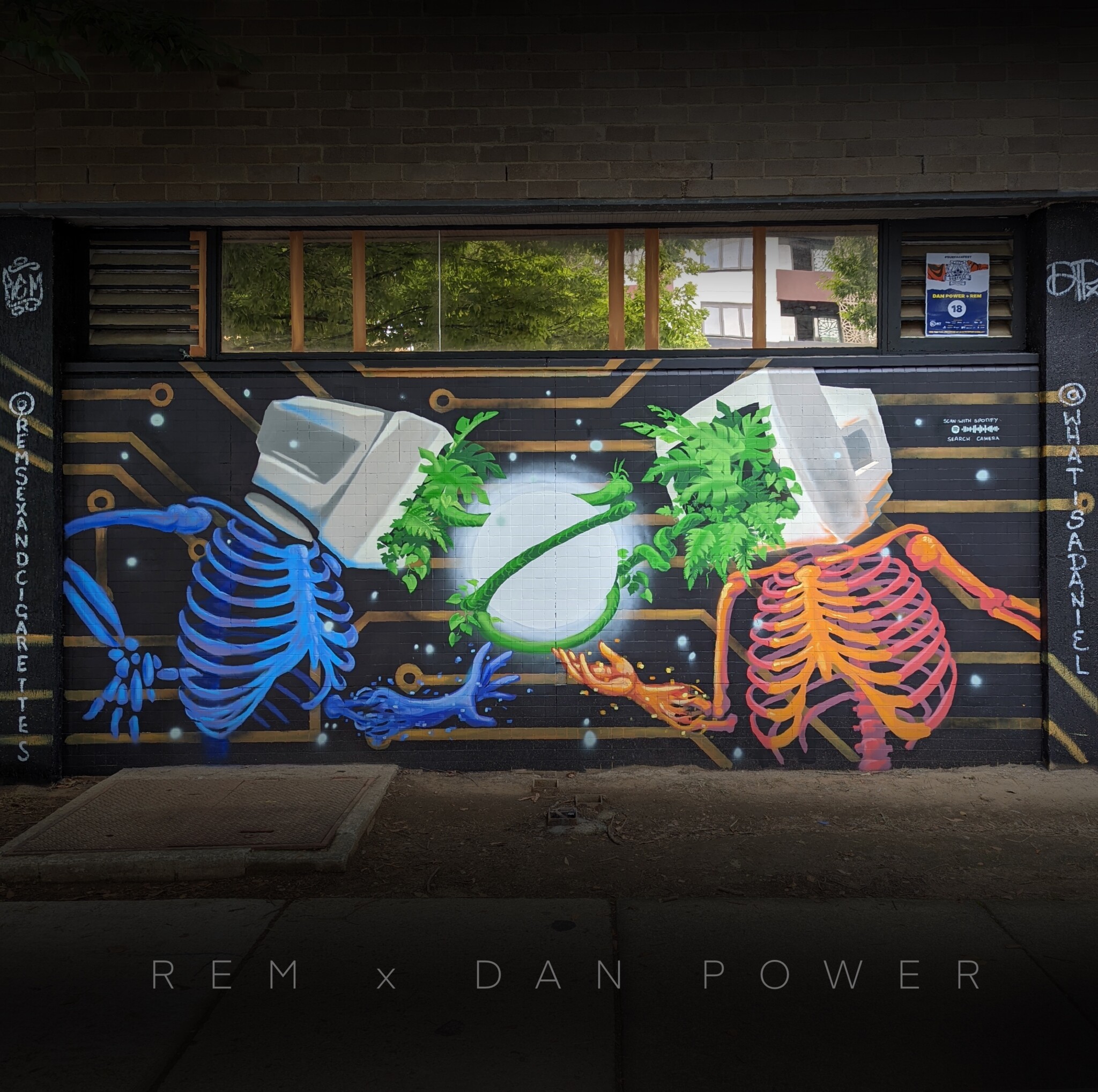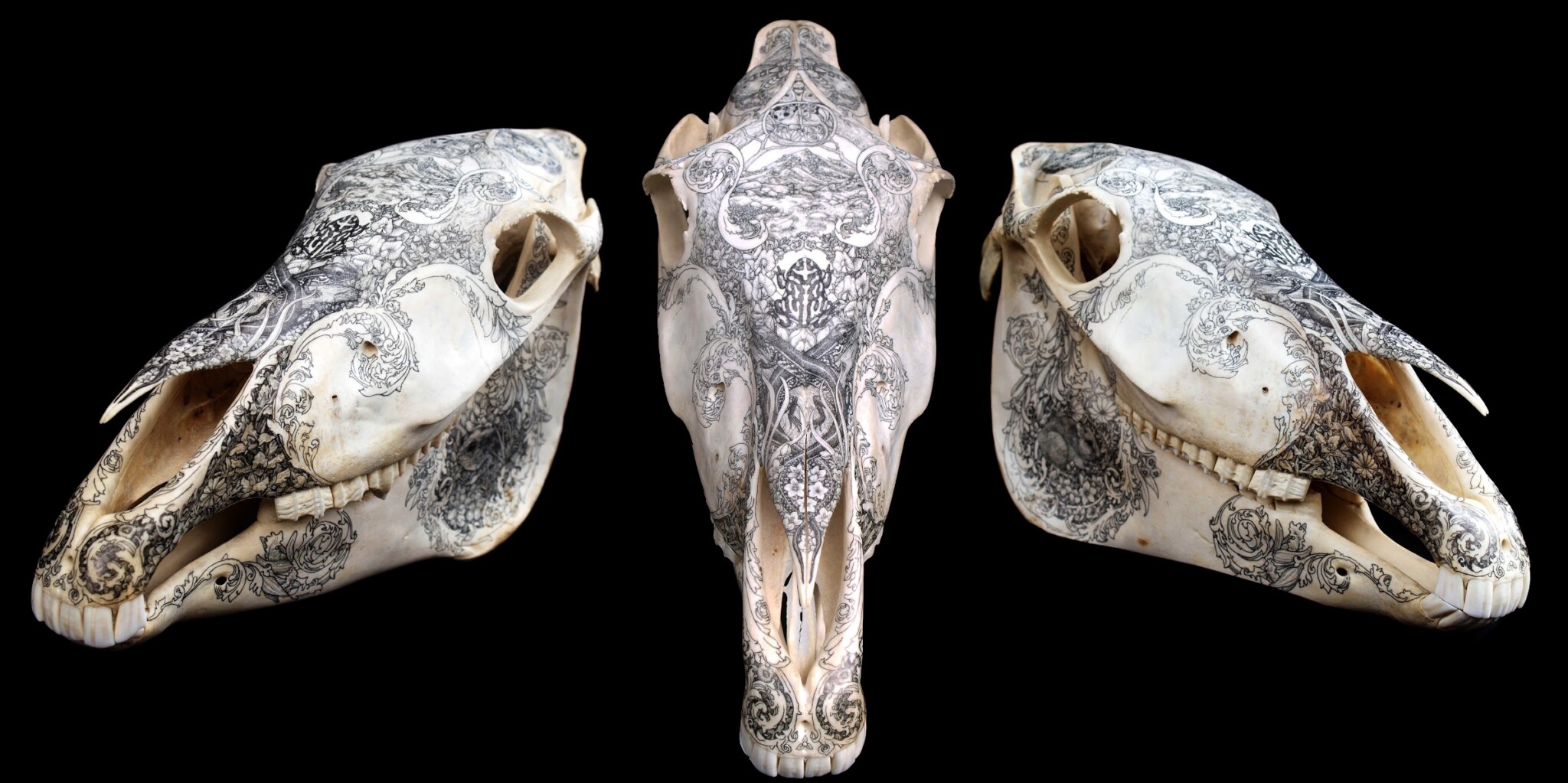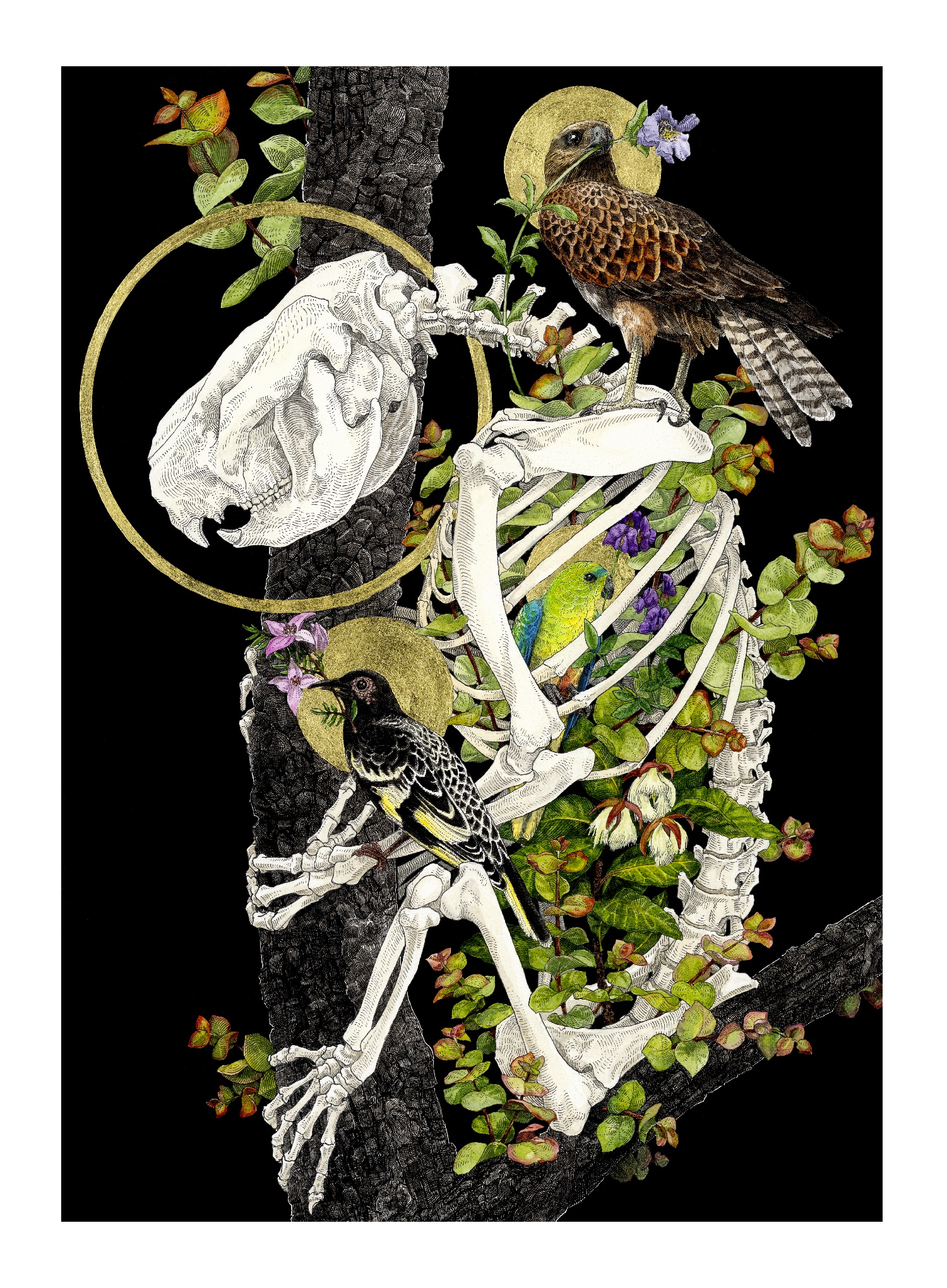A conversation with Anna-Sophie Jürgens and Blake Thompson | Section: Interviews
Series: Street art, Science and Engagement
Abstract: Environmental artist Dan Power shares his insights on the power of art as a subconscious influencer of environment through his work. Combining his university studies of biodiversity and extinction with highly technical art, he critically reflects on the disconnection of human society to nature. His works represent the vast scale of nature and create a space where environmental threats are understandable and relatable, where people can interact with them without switching off. The conversation explores how art cultivates connections with people and allows them to share their anxieties about the environment and environmental threats, which makes these emotions easier to process.
Dan Power, it is a great pleasure to welcome you to the online journal w/k. Your website states that your work “documents and dissects the natural world, conservation and biodiversity in the Anthropocene. A childhood fascination with nature and bones manifested in a Bachelor of Evolutionary Biology” and now permeates your artistic practice and projects. Working in “hyper-detailed illustrations, sculpture, bones and taxidermy”, your art “centres on creating a new natural history that balances ecological grief with the necessity of hope”. However, you have also explored the medium of street art to convey the preciousness and diversity of nature and the narrative of life. You teach illustration techniques, scientific observation skills and nature-based art, and you work as a science communicator and performer at Questacon, the Australian National Science and Technology Centre. In 2016, you were awarded the prestigious Waterhouse Natural Science Art Prize for emerging artists by the South Australian Museum. Following the prize, you exhibited nationally and internationally, undertaking residencies in Italy, Berlin and Australia. All this is very interesting for w/k, and in this article we would like to invite you to reflect on how science and research inspire and shape your work, with the aim of better understanding the artistic concept behind your environmentally themed art.
Hi. Pleased to be here.
Street Art for change? Public art and the environment
This is our series on street art, science and engagement, and your 2022 mural titled Electric Feels – which you created with REM (Lachie Taylor) for the Surface Festival in Canberra – is the cover image of the series’ introduction. We can’t wait to hear more about this mural, even though we know that your work encompasses many other forms of artistic expression and that street art is a relatively new addition to your creative cosmos. How would you define the cultural and transformative power of public art?
Canberra’s art scene is surprisingly diverse for a relatively small city. Street art first appealed to me because it’s not just about displaying artwork, it’s also a performative act – creating something that is always on display. As far as my mural artworks go, I think they are yet to reach the potential of what street art can do in terms of public awareness of science. A new mural, exhibition or sculpture is going to initially catch people’s eye – it’s going to grab their attention and make them think or appreciate it. But, with a thousand other things competing for our attention, momentary awareness of environmental issues is only a very small part of finding solutions. I love the idea that street art, or at least art in public spaces, is able to influence people in the background, to help them absorb the information or the message of the artwork, even when not consciously aware of it. Murals get seen every day as people drive to work or walk down the street, they become ubiquitous and constant, pervasive and persistent. They might notice a mural of an endangered species, appreciate it and let it fade into the background, but the work is still there. With enough exposure, subconscious thoughts start connecting up to how people respond to environmental issues in the media, in conversation, in politics and hopefully, in what action they take towards their solutions.
How would you describe the environmental message of the Electric Feels mural in your own words?
The environmental ‘message’ came purely from collaboration with REM (Lachie Taylor) and was not something that we initially intended for this mural. As a result it is less about themes of conservation or biology – which form the basis of my art practice – and more about getting people to think about their relationship to their environment and about the environment we’ve created for ourselves.

The big, old-fashioned computer monitors were REM’s brainchild, and immediately brought up feelings of interacting with the world through digital facsimiles. This has gone from normal to a necessity during the COVID pandemic and has felt deeply unnatural. This feeling is held in contrast with a more organic ‘nature’ that connects the two figures and asks how we can reconnect with each other and the environment around us. As the figures reach towards this connection with nature, they start to come back to life and flesh materialises on their bones. Humans have been shaped by the natural world for millions of years and it’s a world that we’re better adapted to than isolated apartments and digital spaces. When we interact with the world through a computer screen, we are not doing what the human-mammal brain is designed to do. So the idea is to move away from this strange digital paradigm and reconnect with nature. Humans as a species are adaptable, and it’s one of the main factors that has allowed us to spread across the planet and change it more than any single species ever has. This same adaptability made a digital world the new normal, and that is what now worries me in the context of environmental issues. We adapt to our environment, whatever that environment may be, and in the context of climate change, I am afraid that we are just adapting to the problem instead of treating it as a problem.
One of the things I love about life is that it’s everywhere. If you give it the right conditions, it will sprout, and the idea that life adapts to human systems is really fascinating. I love visiting cities where ferns are growing out of a crack in a building that’s four stories off the ground. Life is literally everywhere around us, and the idea that we have to reconnect with it is kind of absurd. I think that says a lot about how disconnected we are from the environment – and nature.
Research and art exploring the environment
What influence do (environmental) research and science have on this mural, but also on your art in general? What are you currently working on?
I feel like if my art doesn’t have a solid concept behind it, I don’t want to make it. A lot of my work explores biodiversity loss and extinction, and incorporating skulls, skeletons, taxidermy and dead things is a poignant medium for these existentially confronting ideas. For example, I learnt about the role that invasive species play in Australia’s unfolding extinction crisis during my studies at ANU. In 2016, I began a series of animal skulls from invasive species, covered in illustrations exploring the endangered native species at risk. A lot of my works are accompanied by deep-dives into environmental research and policy to identify the key features of the issue and how to best represent them in the work. Thrown in with any number of problems facing the natural world, it feels as if we need to start triaging them. We have to identify which ones are fundamental to natural systems, as well as addressing the individual spot-fires.

My illustration Flagship Species is a clear-cut example of the feedback between research and my work and is inspired by the ecological concept of an umbrella species. Large, charismatic and cute species tend to garner the most conservation dollars, but in protecting their habitats, entire ecosystems and communities are protected as well. I was researching the role of koalas as an umbrella species after the bushfires and came across a paper by PhD candidate Michelle Ward from the University of Queensland on the Use of surrogate species to cost-effectively prioritize conservation actions. It detailed how protecting a handful of species, like the regent honey-eater, could create a network of conservation umbrellas that offers protection to a vast number of threatened species. This idea became the basis for the work.

I don’t think art can solve these complex environmental problems; they need dedication, policy, money, collaboration and action. My hope is that art can make these issues more accessible, on a human level, so that we can re-engage with them, understand their gravity, but not switch off.
A lot of my work is about addressing issues of extinction, death and invasive species. Recently I did a series of works showing skeletons of native animals being overgrown. This was after the 2019/2020 bushfires. These bushfires are actually responsible for the last three years of my artistic practice; they dominated my creativity and making because it was such a visceral experience. After native ecosystems are burnt and decimated, you see green, which is beautiful and hopeful. Things will recover. But we have to acknowledge that what is growing back is not pristine temperate rainforest. If we don’t want thistles to replace endemic wildflowers, then we need to actively help our ecosystems recover. I’m currently working towards an exhibition with the Brunswick St Gallery in Melbourne about fungi. I want to make works to help us shift our mindset from seeing a tree to seeing a forest. From a fungal perspective, it becomes obvious that everything is inextricably linked, related and interdependent.
Art and science: understanding and connecting to the complexity of life on earth
Your work is very research-informed and science-based. How have your engagement with science and your collaboration with scientists and research institutions developed? What artistic results have these explorations led to?
I did my Bachelors in evolution, ecology and zoology at the Australian National University (ANU) and wrote my honours thesis on the evolution of the sexual selection of bugs (I bred, counted and weighed 230000 little insects). I had the option to do a PhD, but I realised that academic science – with its rigorous, repetitive and diligent work – is not for me. I’d been making art my whole life, and in 2014, freed from the shackles of a full-time study, I started my career as an artist.
I’ve collaborated with the planetarium in Perth, the Australian National Insect Collection of the Commonwealth Scientific and Industrial Research Organisation, and the Australian Conservation Foundation. The latter is a non-profit, research-based advocacy group that supports the protection of the environment and biodiversity. I got to know them when I was studying environmental problems and trying to figure out how to solve them – do you chain yourself to a tree or do you lobby for government action or policy change? They helped me to figure out which measures would be most effective.
In a 2016 interview, when you were awarded the Waterhouse Natural Science Art Prize, you said that your mission as an artist is to “promote communication of science, through other means, namely art itself, as a way of actually presenting scientific concepts and ideas” (The Canberra Times). Please tell us a little more: What artistic goals do you pursue in your engagement with science(s)?
Australia is leading the world in animal extinction. We have some of the most unique flora and fauna and we’re just letting it go extinct. This is unacceptable. If there is one thing that I could change in my lifetime, in my art and my career, it is this. I want my art to help people understand and connect to the complexity of these environmental issues. I don’t make art that is purely representative, I want my art to come from a knowledge-based understanding of what is happening and why it is happening.
One thing I really struggled with in my experience in academia is that scientists spend their careers synthesising incredibly valuable information. They have spent so much time and energy trying to figure things out, gather and interpret the data and prove that changes are happening (most researchers agree that climate change is happening, for example), but it can be so abstract. So how do you get people – who have jobs and children or other interests – to understand these things? When you open the news, you see all these depressing facts about species extinction, soil loss, bees dying or climate change – it’s just sensory overload. It’s hard, but if there’s one advantage of art, it’s the fact that it can get people to connect with something on an individual level. People will have their own individual moment with what you’ve created or what they’re looking at. If you can curate that experience as an artist, where people have a moment where they connect with it on an emotional, human level, then it can break through the noise and allow the scientific realities to seep through.
How does your art enable a deeper understanding of both environmental sustainability, fragility, urgency and the research/sciences that shaped your approach? Why is it important to bring environmental science and art together in public spaces?
Science spends so much time trying to represent the world as it actually is and how and why things are happening; increasingly, it’s bad news. That is, if science doesn’t necessarily inspire hope about how the natural world is going to evolve or recover, then it’s the job of art to provide that hope. Both art and science tell stories, but art doesn’t just have to tell stories about how the world is, but how the world could be. It’s about imagining a future where you know things can be different. Instead of just focusing on how everything is dying out, art can provide hope. That’s where we can try to twist all the depressing stuff and put in dashes of hope – ideally ones that are based in reality. It’s difficult because you really have to look for it, but if you don’t have hope, all is lost. If you can cultivate hope for the future, you can take meaningful action. Public art has an invaluable role in subliminally communicating to people that we need to take action on climate change and tackle the extinction crisis in Australia.

How have your environmental artworks (including your mural) been received by the public, researchers and other artists?
People seem to find something valuable in my work. I know that lots of details get lost in notebooks and nuance, or that my representations aren’t always as biologically precise as I’d like them to be. But the moments when someone recognises a species or clearly reads into an issue are magic. Hauntingly beautiful is one of my favourite descriptions of it. I think of the beauty of nature reflected in my work as the hook, the thing that arrests people’s attention and draws them in. It makes them engage with things that are confronting – like death and extinction – without writing it off as too macabre.
My works on the bushfires seem to open up pockets of environmental grief, or feelings of loss that people suppressed at the time. The mural with REM seemed to elicit a similar response from people with respect to a feeling of disconnect during COVID-19. It’s deeply rewarding to create these windows that help people process the emotional reactions to complex environmental problems. Street art is an opportunity to create a bigger window for more eyes to see. Recognising that the feelings of anxiety, apathy or bewilderment that come with environmental issues are shared by others makes them easier to process.
If someone were to ask you to invent a science, what would it be?
Telepathic empathy that transcends species.
Dan, thank you so much for this thoughtful and thought-provoking conversation!
Details of the cover photo: Dan Power: Epiphyte 1 (2018). Pen and ink and gold leaf on paper. Photo: Dan Power.
How to cite this article
Dan Power, Anna-Sophie Jürgens and Blake Thompson (2022): Dan Power: Art and Environmental Fragility. w/k–Between Science & Art Journal. https://doi.org/10.55597/e7767


Be First to Comment